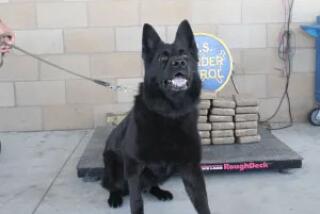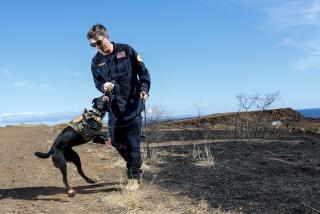A Few Good Noses : INS Demonstrates Dogged Agents of Detection
- Share via
LAGUNA NIGUEL — On cue, Rex feverishly circled the late model Mercury, following his nose from the hubcaps to the wheel wells and then to the trunk.
There, the 8-year-old dog sat and barked. He was telling his handler, Christina Ibrahim, a supervisor and inspector for the Immigration and Naturalization Service, that someone was hiding inside. In this simulation, a check of the trunk showed that once again, Rex had found his man--an illegal immigrant.
“We’d like to have a lot more like him,” Ibrahim said during a demonstration of Rex’s and four other dogs’ abilities Thursday at the INS western region headquarters in Laguna Niguel. “They have the ability to find people in planes, trains, boats or cars, any type of vehicle used to gain entry into the U.S. And they are very happy employees. They never call in sick.”
Since 1988, the INS has used specially trained dogs to help seek out illegal immigrants at border crossings and checkpoints around the country. Although the INS agents insist that the dogs are well-trained and non-aggressive, the practice has been criticized by immigration rights activists.
Roberto Martinez, a spokesman for the San Diego-based American Friends Service Committee, said Thursday that his group receives daily complaints of serious mistreatment of migrants crossing the border, including two alleged attacks in recent years when dogs were turned loose on people by their handlers.
“It all depends on the dog’s handler,” Martinez said. “It is something we are watching very carefully.”
This week, with the dogs in Orange County for their regular certification by the Orange County Sheriff’s Department, they put on a show in front of about 60 onlookers and television camera crews.
In simulations, Rex and the other canines detected a man hiding in the trunk of a car, a bag of marijuana in a car’s wheel well, and a container of a cocaine-like substance in a muffler--all on a windy day and each in a matter of seconds.
When the dogs locate a person or a substance, they immediately sit and bark, but they don’t attack, said Michael Goodwin, another INS dog handler. It’s called the passive-alert technique, and the dogs learn through constant repetition followed by the reward of a treat, he said.
“They are very gentle and do not hurt anyone they find in any way,” Goodwin said. “This is play to them. They are having fun.”
Virginia Kice, an INS spokeswoman, said she had never heard of their dogs attacking anyone.
“I am not aware of any such cases at ports of entry by INS dogs,” said Kice, who has worked for the INS for four years. “These dogs are not attack dogs. They are trained specifically in the passive-alert technique. They don’t attack people.”
The INS dogs, which cost between $5,000 and $6,000 fully trained, resemble German shepherds but actually are of the Belgian Malinois breed from Germany. They live with their handlers and their families 24 hours a day and will work as long as eight to 10 years before they are retired from duty, Ibrahim said.
Although these dogs are already credited with sniffing out $34 million in illicit drugs nationwide, their chief responsibility parallels that of the INS--finding illegal immigrants. Illicit drugs and merchandise are mainly the charge of the U.S. Customs Service, Kice said.
Once in awhile, in an emergency such as the last major San Francisco earthquake, the dogs will be called on to help find people in the wreckage of buildings, Ibrahim said.
“These dogs work well in search and rescue and found people trapped in debris,” she said.
But with 525 million people--both legal and illegal--passing through U.S. borders in 1992 alone, 50,000 daily at San Ysidro on the Mexican border, it is the INS agents who need their help, Ibrahim said.
“Smugglers have nothing else to do but think of ways to hide people and drugs,” she said. “There are a million ways to do it.”
Ibrahim, who works out of the INS’ San Ysidro office, said she and Rex and the other dogs have found people hiding in refrigerators of motor homes, squeezed under the hood of a Volkswagen Beetle, and in all kinds of special compartments especially made for smuggling.
More to Read
Sign up for Essential California
The most important California stories and recommendations in your inbox every morning.
You may occasionally receive promotional content from the Los Angeles Times.













